An Optical Method to Characterize Streamer Variability and Streamer-to-Flame Transition for Radio-Frequency Corona Discharges
Abstract
Featured Application
Abstract
1. Introduction
2. Materials and Methods
2.1. Optical Engine
2.2. Imaging System
2.3. Igniter
2.4. Operation
- Starting from rest, the dynamic brake motored the optical engine up to the desired rotational speed (test point speed, e.g., 1000 rpm) with no combustion, since the fuel line was not powered. Conversely, the ignition system was active, and the corona igniter was able to generate streamers inside the combustion chamber.
- Optical and indicating acquisitions were carried out.
- When the acquisition was over, the dynamic brake was operated to stop the engine.
- Starting from rest, the dynamic brake motored the optical engine up to the desired rotational speed (test point speed, e.g., 1000 rpm) with no combustion, since the fuel line was not yet powered. Conversely, the ignition system was active, and the corona igniter was able to generate streamers inside the combustion chamber.
- The fuel line was then powered. Streamers ignited the air–fuel mixture in the combustion chamber of the optical engine. The latter started generating a positive torque, and, as usual, the dynamic brake adjusted its resistance to maintain the desired speed.
- Optical and indicating acquisitions were carried out.
- When the acquisition was over, the fuel supply was cut off, and the dynamic brake was operated to stop the engine.
3. Case Study
4. Optical Methods
4.1. Preliminary Operations
4.1.1. Average Background Computation and Removal, Equalization
4.1.2. Filtering
4.1.3. Thresholding and Binarization
4.1.4. Hole Filling
4.1.5. Binarized Area Computation and Boundary Recognition
4.1.6. Quadrant Selection
4.2. Streamer Variability Calculation
4.3. Streamer-to-Flame Transition Detection
- For each combustion and for each quadrant, the binarized area trend was smoothed by using a five-point moving average. The five-point choice was found to be a good trade-off between the wobbly raw data and an even stronger smooth curve, which loses responsiveness.
- Once smoothed, the series was compared with the average trend in motored conditions (i.e., where no combustion occurs).
- The point of transition was determined by looking for a non-negligible increase in binarized area slope, which should occur in close proximity to the intersection between the combustion curve and the motored average one. After such a point, a region of strong increase in binarized area, not necessarily monotonic, should occur.
5. Results and Discussion
5.1. Streamer Variability
5.2. Streamer-to-Flame Transition
6. Conclusions
- A stable preprocessing method was determined, based on in-house MATLAB scripts together with built-in functions. It consisted of average background removal, equalization, Gaussian filtering, and thresholding. The threshold level was defined manually, frame by frame, but the threshold level to discriminate dark and light pixels belonged to an easily detectable narrow range. The procedure continued with binarization, hole filling, and boundary recognition. Finally, the frame area was divided into four quadrants, in order to analyze the discharge events from the corona tips independently from each other.
- A method to evaluate streamer repeatability in motored conditions was reported. For each discharge event, the maximum penetration (i.e., the maximum distance between streamer and tip) over time was detected. The maxima values, one for each consecutive discharge, were compared, and a statistical analysis was carried out, where the average value, standard deviation, and coefficient of variation were computed. This procedure was carried out separately for each igniter tip.
- A method to discriminate frames with pure streamer from combustion frames was reported. It was based on the evolution of the binarized area, evaluated separately for each electrode tip. The first significant increase in slope that generated a deviation between the binarized area trend and the corresponding motored one was defined as the detection condition for the flame presence.
- For the motored test case, as an example, the streamer penetration parameters were calculated. According to the nomenclature used in this work, the highest streamer penetration, on average, was found for the fourth tip (more than 7 mm), while the second and third tips featured with the lowest penetration (about 4 mm). Standard deviation, on the contrary, was not so different among the four tips (0.9–1.0 mm).
- By applying the method to detect the transition between streamer and flames, it was found that all visible flames were always present at the end of the discharge. On average, at fixed lambda, it was not possible to find a tip-dependent trend. Focusing on the tip, instead, a lower lambda resulted in more advanced early flame detection. Nevertheless, the average gap in the first frame with combustion between the three lambda values was small (at most three frames, i.e., about 0.2 crank angle degrees).
Author Contributions
Funding
Conflicts of Interest
Glossary and Nomenclature
| 3D-CFD | three dimensional computational fluid dynamics |
| ACIS | Advanced Corona Ignition System |
| AFR | air–fuel ratio |
| aSOD | after the start of discharge |
| BCKavg | average background frame |
| CAD | crank angle degree |
| CCV | cycle-to-cycle variability |
| CMOS | complementary metal-oxide semiconductor |
| CoV | coefficient of variation |
| ET | energizing time |
| ECU | engine control unit |
| EGR | exhaust gas recirculation |
| FM | Federal Mogul Powertrain Italy, a Tenneco Group Company |
| fps | frames per second |
| FS | full scale |
| GDI | gasoline direct injection |
| IMEP | indicated mean effective pressure |
| IT | ignition timing |
| LTP | low-temperature plasma |
| MBT | maximum brake torque |
| MFB | mass fraction burned |
| MON | motor octane number |
| P | streamer penetration for a certain frame |
| Pmax | maximum streamer penetration referred to a discharge |
| PFI | port fuel injection |
| RF | radio-frequency |
| RON | research octane number |
| SI | spark ignition |
| Td | corona discharge duration |
| Vd | driving voltage |
| λ | relative air–fuel ratio |
| θ50 | crank angle of mass fraction burned = 50% |
References
- Thangaraja, J.; Kannan, C. Effect of Exhaust Gas Recirculation on Advanced Diesel Combustion and Alternate Fuels—A Review. Appl. Energy 2016, 180, 169–184. [Google Scholar] [CrossRef]
- Battistoni, M.; Grimaldi, C.N.; Cruccolini, V.; Discepoli, G.; De Cesare, M. Assessment of Port Water Injection Strategies to Control Knock in a GDI Engine through Multi-Cycle CFD Simulations. SAE Tech. Pap. 2017, 14. [Google Scholar] [CrossRef]
- Nakata, K.; Nogawa, S.; Takahashi, D.; Yoshihara, Y.; Kumagai, A.; Suzuki, T. Engine Technologies for Achieving 45% Thermal Efficiency of S.I. Engine. SAE Int. J. Engines 2015, 9. [Google Scholar] [CrossRef]
- Huang, S.; Zhang, Z.; Song, H.; Wu, Y.; Li, Y. A Novel Way to Enhance the Spark Plasma-Assisted Ignition for an Aero-Engine Under Low Pressure. Appl. Sci. 2018, 8, 1533. [Google Scholar] [CrossRef]
- Zembi, J.; Mariani, F.; Battistoni, M. Large Eddy Simulation of Ignition and Combustion Stability in a Lean SI Optical Access Engine. SAE Tech. Pap. 2019, 13. [Google Scholar] [CrossRef]
- Scarcelli, R.; Zhang, A.; Wallner, T.; Breden, D.; Karpatne, A.; Raja, L.; Ekoto, I.; Wolk, B. Multi-dimensional Modeling of Non-equilibrium Plasma for Automotive Applications. SAE Tech. Pap. 2018, 1–10. [Google Scholar] [CrossRef]
- Nishiyama, A.; Le, M.K.; Furui, T.; Ikeda, Y. The Relationship between In-Cylinder Flow-Field near Spark Plug Areas, the Spark Behavior, and the Combustion Performance inside an Optical S.I. Engine. Appl. Sci. 2019, 9, 1545. [Google Scholar] [CrossRef]
- Breden, D.; Karpatne, A.; Suzuki, K.; Raja, L. High-Fidelity Numerical Modeling of Spark Plug Erosion. SAE Tech. Pap. Ser. 2019, 1, 1–12. [Google Scholar] [CrossRef]
- Yang, Z.; Yu, X.; Yu, S.; Han, X.; Tan, Q.; Chen, G.; Chen, X.; Zheng, M. Effects of Spark Discharge Energy Scheduling on Flame Kernel Formation under Quiescent and Flow Conditions. SAE Tech. Pap. 2019, 1–11. [Google Scholar] [CrossRef]
- Shiraishi, T.; Urushihara, T.; Gundersen, M. A trial of ignition innovation of gasoline engine by nanosecond pulsed low temperature plasma ignition. J. Phys. D Appl. Phys. 2009, 42, 135208. [Google Scholar] [CrossRef]
- Cruccolini, V.; Discepoli, G.; Cimarello, A.; Battistoni, M.; Mariani, F.; Grimaldi, C.N.; Dal Re, M.A. Lean combustion analysis using a corona discharge igniter in an optical engine fueled with methane and a hydrogen-methane blend. Fuel 2020, 259, 116290. [Google Scholar] [CrossRef]
- Idicheria, C.A.; Yun, H.; Najt, P.M. An Advanced Ignition System for High Efficiency Engines. In Ignition Systems for Gasoline Engines, Proceedings of the 4th International Conference, Berlin, Germany, 6–7 December 2018; Expert Verlag: Tübingen, Germany, 2018; pp. 40–54. [Google Scholar] [CrossRef]
- Kuramochi, A.; Takahashi, E.; Asakawa, D.; Saito, N.; Nishioka, M. Flame Propagation Enhancement by Dielectric Barrier Discharge-Generated Intermediate Species. Combust. Sci. Technol. 2019, 191, 1972–1989. [Google Scholar] [CrossRef]
- Marko, F.; König, G.; Schöffler, T.; Bohne, S.; Dinkelacker, F. Comparative Optical and Thermodynamic Investigations of High Frequency Corona- and Spark-Ignition on a CV Natural Gas Research Engine Operated with Charge Dilution by Exhaust Gas Recirculation. In Ignition Systems for Gasoline Engines; Springer International Publishing: Cham, Switzerland, 2017; pp. 293–314. ISBN 978-3-319-45503-7. [Google Scholar] [CrossRef]
- Cimarello, A.; Grimaldi, C.N.; Mariani, F.; Battistoni, M.; Dal Re, M. Analysis of RF Corona Ignition in Lean Operating Conditions Using an Optical Access Engine. SAE Tech. Pap. 2017, 16. [Google Scholar] [CrossRef]
- Merola, S.S.; Marchitto, L.; Tornatore, C.; Valentino, G.; Irimescu, A. Optical Characterization of Combustion Processes in a DISI Engine Equipped with Plasma-Assisted Ignition System. Appl. Therm. Eng. 2014, 69, 177–187. [Google Scholar] [CrossRef]
- Ju, Y.; Sun, W. Plasma assisted combustion: Dynamics and chemistry. Prog. Energy Combust. Sci. 2015, 48, 21–83. [Google Scholar] [CrossRef]
- Pineda, D.I.; Wolk, B.; Chen, J.-Y.; Dibble, R.W. Application of Corona Discharge Ignition in a Boosted Direct-Injection Single Cylinder Gasoline Engine: Effects on Combustion Phasing, Fuel Consumption, and Emissions. SAE Int. J. Engines 2016, 9. [Google Scholar] [CrossRef]
- Burrows, J.; Mixell, K.; Reinicke, P.B.; Riess, M.; Sens, M. Corona Ignition—Assessment of Physical Effects by Pressure Chamber, Rapid Compression Machine, and Single Cylinder Engine Testing. In Ignition Systems for Gasoline Engines, Proceedings of the 2nd International Conference; Berlin, Germany, 24–25 November 2014, pp. 87–107. ISBN 9783944976228.
- Burrows, J.; Mixell, K. Analytical and Experimental Optimization of the Advanced Corona Ignition System. In Ignition Systems for Gasoline Engines; Springer International Publishing: Cham, Switzerland, 2016; pp. 267–292. [Google Scholar] [CrossRef]
- Discepoli, G.; Cruccolini, V.; Ricci, F.; Di Giuseppe, A.; Papi, S.; Grimaldi, C.N. Experimental characterisation of the thermal energy released by a Radio-Frequency Corona Igniter in nitrogen and air. Appl. Energy 2020, 263, 114617. [Google Scholar] [CrossRef]
- Suess, M.; Guenthner, M.; Schenk, M.; Rottengruber, H. Investigation of the Potential of Corona Ignition to Control Gasoline Homogeneous Charge Compression Ignition Combustion. Proc. Inst. Mech. Eng. Part D J. Automob. Eng. 2012, 226, 275–286. [Google Scholar] [CrossRef]
- Pastor, J.; Olmeda, P.; Martín, J.; Lewiski, F. Methodology for Optical Engine Characterization by Means of the Combination of Experimental and Modeling Techniques. Appl. Sci. 2018, 8, 2571. [Google Scholar] [CrossRef]
- Koegl, M.; Baderschneider, K.; Bauer, F.J.; Hofbeck, B.; Berrocal, E.; Will, S.; Zigan, L. Analysis of the LIF/Mie Ratio from Individual Droplets for Planar Droplet Sizing: Application to Gasoline Fuels and Their Mixtures with Ethanol. Appl. Sci. 2019, 9, 4900. [Google Scholar] [CrossRef]
- Nishiyama, A.; Le, M.K.; Furui, T.; Ikeda, Y. Simultaneous In-Cylinder Flow Measurement and Flame Imaging in a Realistic Operating Engine Environment Using High-Speed PIV. Appl. Sci. 2019, 9, 2678. [Google Scholar] [CrossRef]
- Martinez, S.; Merola, S.; Irimescu, A. Flame Front and Burned Gas Characteristics for Different Split Injection Ratios and Phasing in an Optical GDI Engine. Appl. Sci. 2019, 9, 449. [Google Scholar] [CrossRef]
- Irimescu, A.; Marchitto, L.; Merola, S.S.; Tornatore, C.; Valentino, G. Evaluation of Different Methods for Combined Thermodynamic and Optical Analysis of Combustion in Spark Ignition Engines. Energy Convers. Manag. 2014, 87, 914–927. [Google Scholar] [CrossRef]
- Michalski, Q.; Benito Parejo, C.J.; Claverie, A.; Sotton, J.S.; Bellenoue, M. An Application of Speckle-Based Background Oriented Schlieren for Optical Calorimetry. Exp. Therm. Fluid Sci. 2018, 91, 470–478. [Google Scholar] [CrossRef]
- Sun, L.; Meng, X.; Xu, J.; Tian, Y. An Image Segmentation Method Using an Active Contour Model Based on Improved SPF and LIF. Appl. Sci. 2018, 8, 2576. [Google Scholar] [CrossRef]
- Otsu, N. A Threshold Selection Method from Gray-Level Histograms. IEEE Trans. Syst. Man Cybern. 1979, 9, 62–66. [Google Scholar] [CrossRef]
- Shawal, S.; Goschutz, M.; Schild, M.; Kaiser, S.A.; Neurohr, M.; Pfeil, J.; Koch, T. High-Speed Imaging of Early Flame Growth in Spark-Ignited Engines Using Different Imaging Systems via Endoscopic and Full Optical Access. SAE Int. J. Engines 2016, 9. [Google Scholar] [CrossRef]
- Cimarello, A.; Cruccolini, V.; Discepoli, G.; Battistoni, M.; Mariani, F.; Grimaldi, C.N.; Dal Re, M. Combustion Behavior of an RF Corona Ignition System with Different Control Strategies. SAE Tech. Pap. 2018, 1–19. [Google Scholar] [CrossRef]
- Cruccolini, V.; Discepoli, G.; Ricci, F.; Petrucci, L.; Grimaldi, C.N.; Papi, S.; Dal Re, M. Comparative Analysis between a Barrier Discharge Igniter and a Streamer-type Radio-Frequency Corona Igniter in an Optically Accessible Engine in Lean Operating Conditions. SAE Tech. Pap. 2020, 12. [Google Scholar] [CrossRef]
- Discepoli, G.; Cruccolini, V.; Dal Re, M.; Zembi, J.; Battistoni, M.; Mariani, F.; Grimaldi, C.N. Experimental Assessment of Spark and Corona Igniters Energy Release. Energy Procedia 2018, 148, 1262–1269. [Google Scholar] [CrossRef]
- Loeb, L.B. Electrical Coronas: Their Basic Physical Mechanisms; University of California Press: Berkeley, CA, USA, 1965; ISBN 9780520007659. [Google Scholar]
- Scarcelli, R.; Wallner, T.; Som, S.; Biswas, S.; Ekoto, I.; Breden, D.; Karpatne, A.; Raja, L. Modeling Non-Equilibrium Discharge and Validating Transient Plasma Characteristics at Above-Atmospheric Pressure. Plasma Source Sci. Technol. 2018, 27, 124006. [Google Scholar] [CrossRef]
- Qin, J.; Pasko, V.P. On the propagation of streamers in electrical discharges. J. Phys. D Appl. Phys. 2014, 47, 435202. [Google Scholar] [CrossRef]
- Ricci, F.; Zembi, J.; Battistoni, M.; Grimaldi, C.N.; Discepoli, G.; Petrucci, L. Experimental and Numerical Investigations of the Early Flame Development Produced by a Corona Igniter. SAE Tech. Pap. Ser. 2019, 12. [Google Scholar] [CrossRef]
- Bhatti, S.S.; Verma, S.; Tyagi, S.K. Energy and Exergy Based Performance Evaluation of Variable Compression Ratio Spark Ignition Engine Based on Experimental Work. Therm. Sci. Eng. Prog. 2019, 9, 332–339. [Google Scholar] [CrossRef]
- Terry, O.; Rochussen, J.; Kirchen, P. Development of a Modular, Dry-Running Bowditch Piston with Efficient Window Cleaning. SAE Tech. Pap. 2018, 1–14. [Google Scholar] [CrossRef]
- Irimescu, A.; Tornatore, C.; Marchitto, L.; Merola, S.S. Compression Ratio and Blow-By Rates Estimation Based on Motored Pressure Trace Analysis for an Optical Spark Ignition Engine. Appl. Therm. Eng. 2013, 61, 101–109. [Google Scholar] [CrossRef]
- SAE J1832_200102, Low Pressure Gasoline Fuel Injector, SAE International Standard; SAE International: Warrendale, PA, USA, 2001. [CrossRef]
- Phantom V71X—Color & Spectral Response Curve. Available online: https://www.phantomhighspeed.com/products/cameras/vseries/v711 (accessed on 15 January 2020).
- Romani, L.; Bianchini, A.; Vichi, G.; Bellissima, A.; Ferrara, G. Experimental Assessment of a Methodology for the Indirect in-Cylinder Pressure Evaluation in Four-Stroke Internal Combustion Engines. Energies 2018, 11, 1982. [Google Scholar] [CrossRef]
- Ganesh, S.; Rajabooshanam, A.; Dhali, S.K. Numerical Studies of Streamer to Arc Transition. J. Appl. Phys. 1922, 72, 3957–3965. [Google Scholar] [CrossRef]
- Kuffel, E.; Kuffel, J. High Voltage Engineering Fundamentals, 2nd ed.; Elsevier: Oxford, UK, 2000; ISBN 9780750636346. [Google Scholar] [CrossRef]
- Semmlow, J. Two-Dimensional Signals—Basic Image Analysis. In Circuits, Signals and Systems for Bioengineers; Academic Press: Cambridge, MA, USA, 2018; pp. 491–526. [Google Scholar] [CrossRef]
- Wolk, B.M.; Ekoto, I. Calorimetry and Imaging of Plasma Produced by a Pulsed Nanosecond Discharge Igniter in EGR Gases at Engine-Relevant Densities. SAE Int. J. Engines 2017, 10. [Google Scholar] [CrossRef]
- Aleiferis, P.G.; Serras-Pereira, J.; Richardson, D. Characterisation of Flame Development with Ethanol, Butanol, Iso-Octane, Gasoline and Methane in a Direct-Injection Spark-Ignition Engine. Fuel 2013, 109, 256–278. [Google Scholar] [CrossRef]
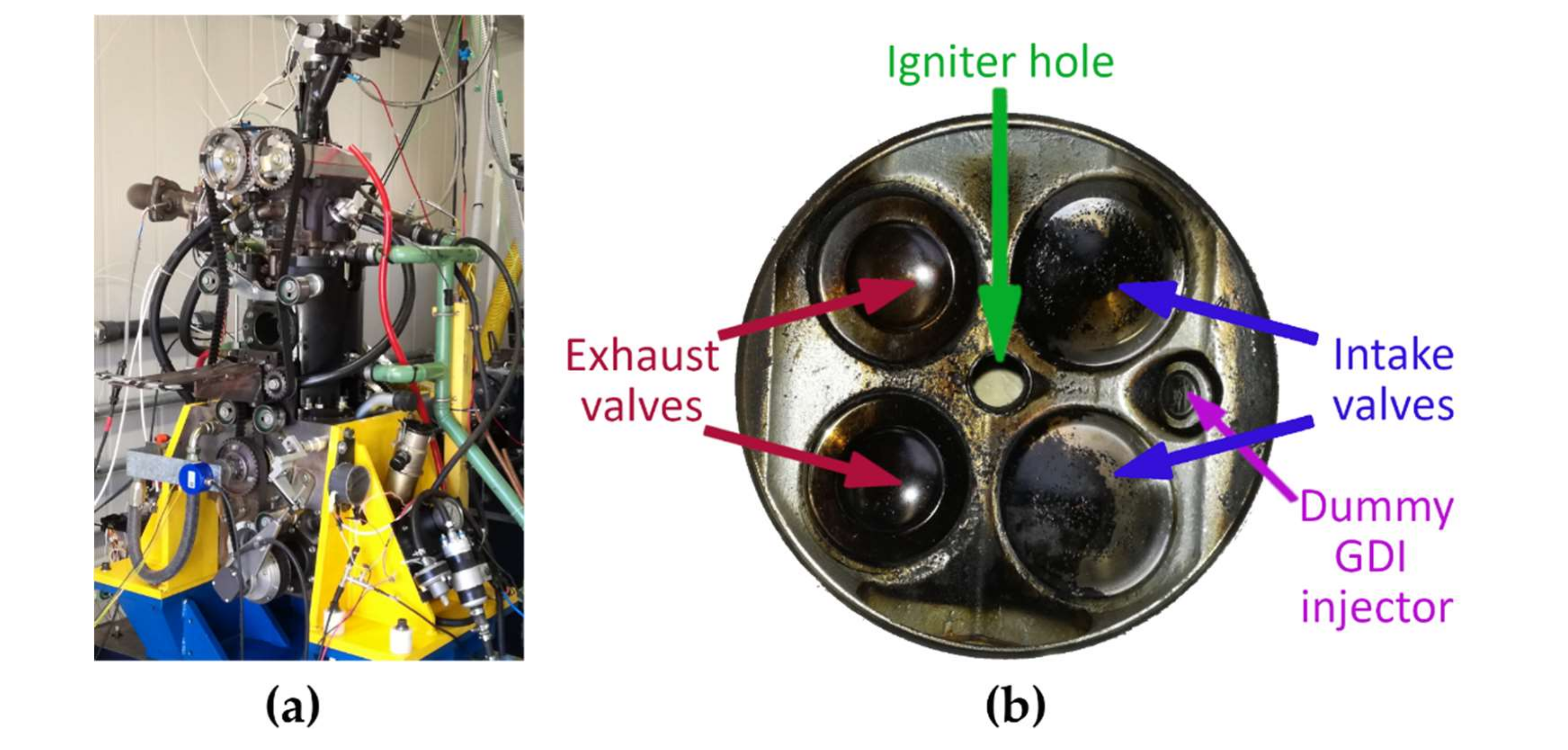
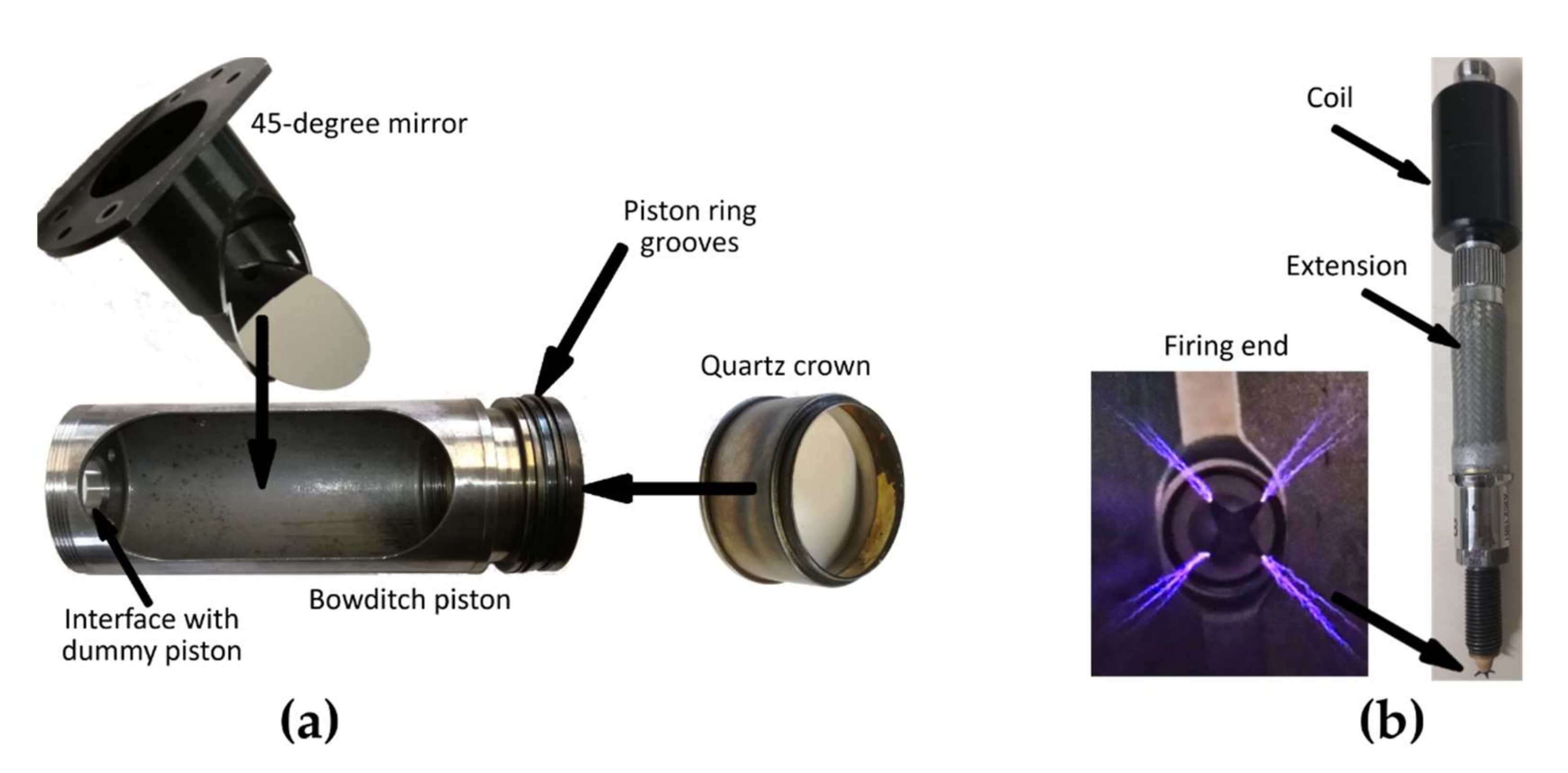

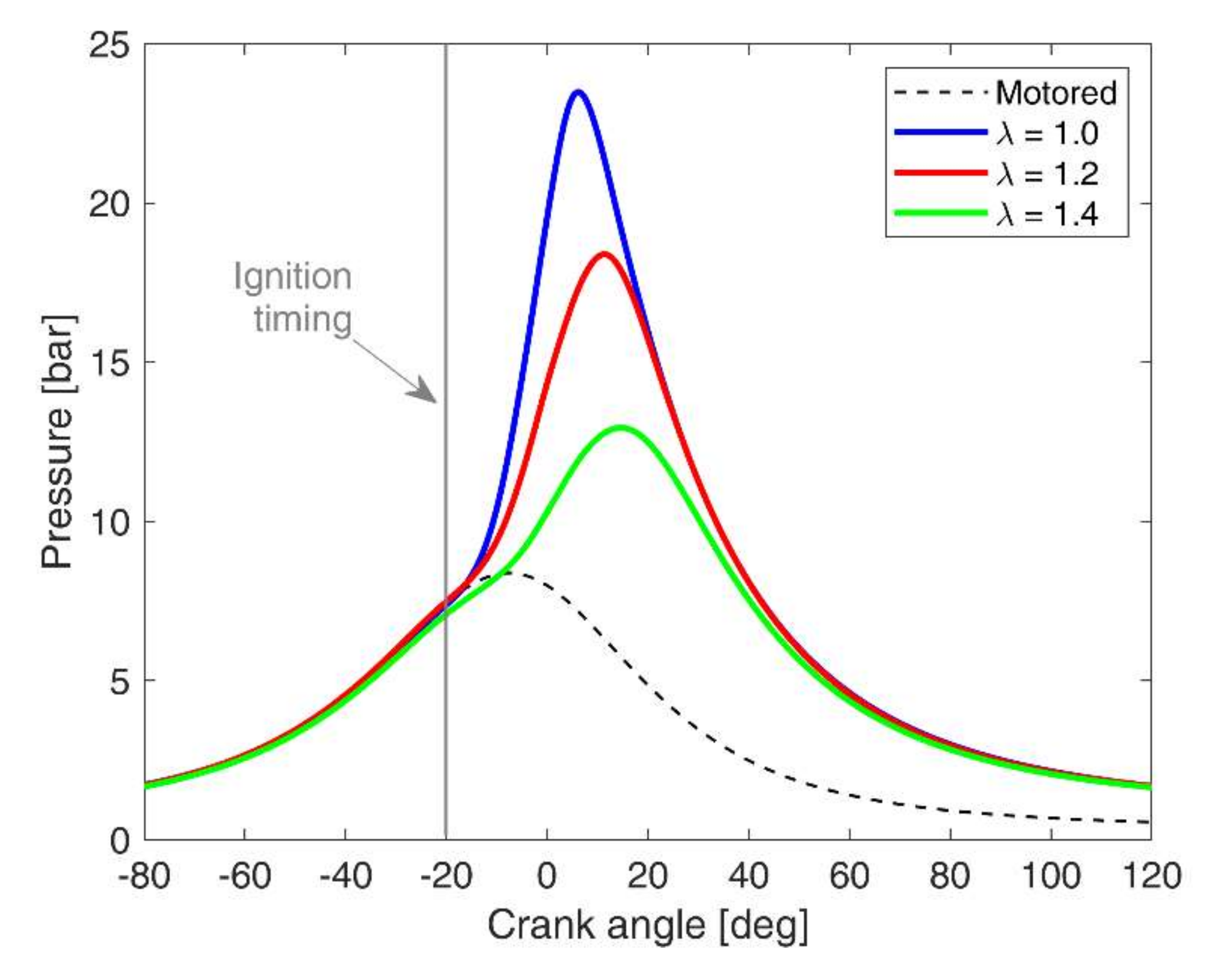
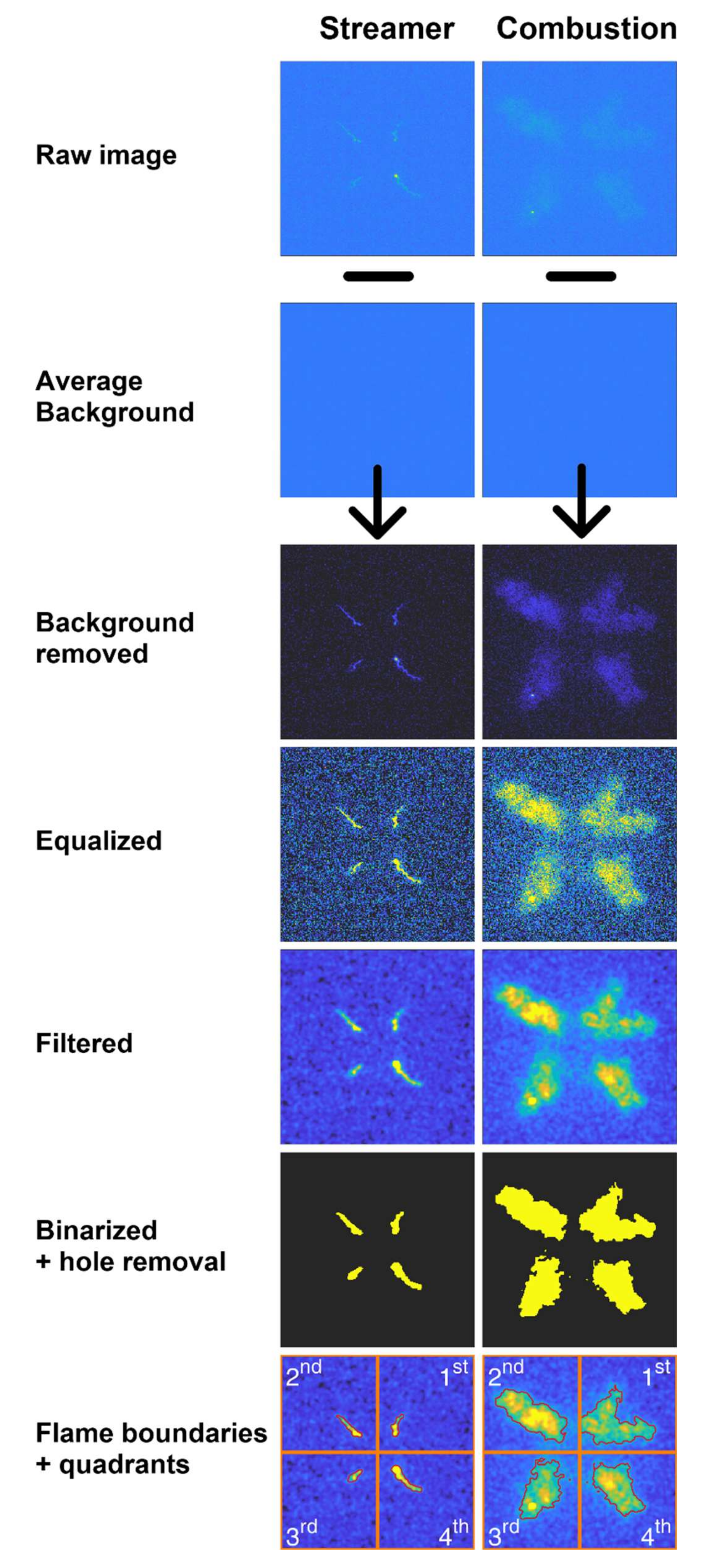
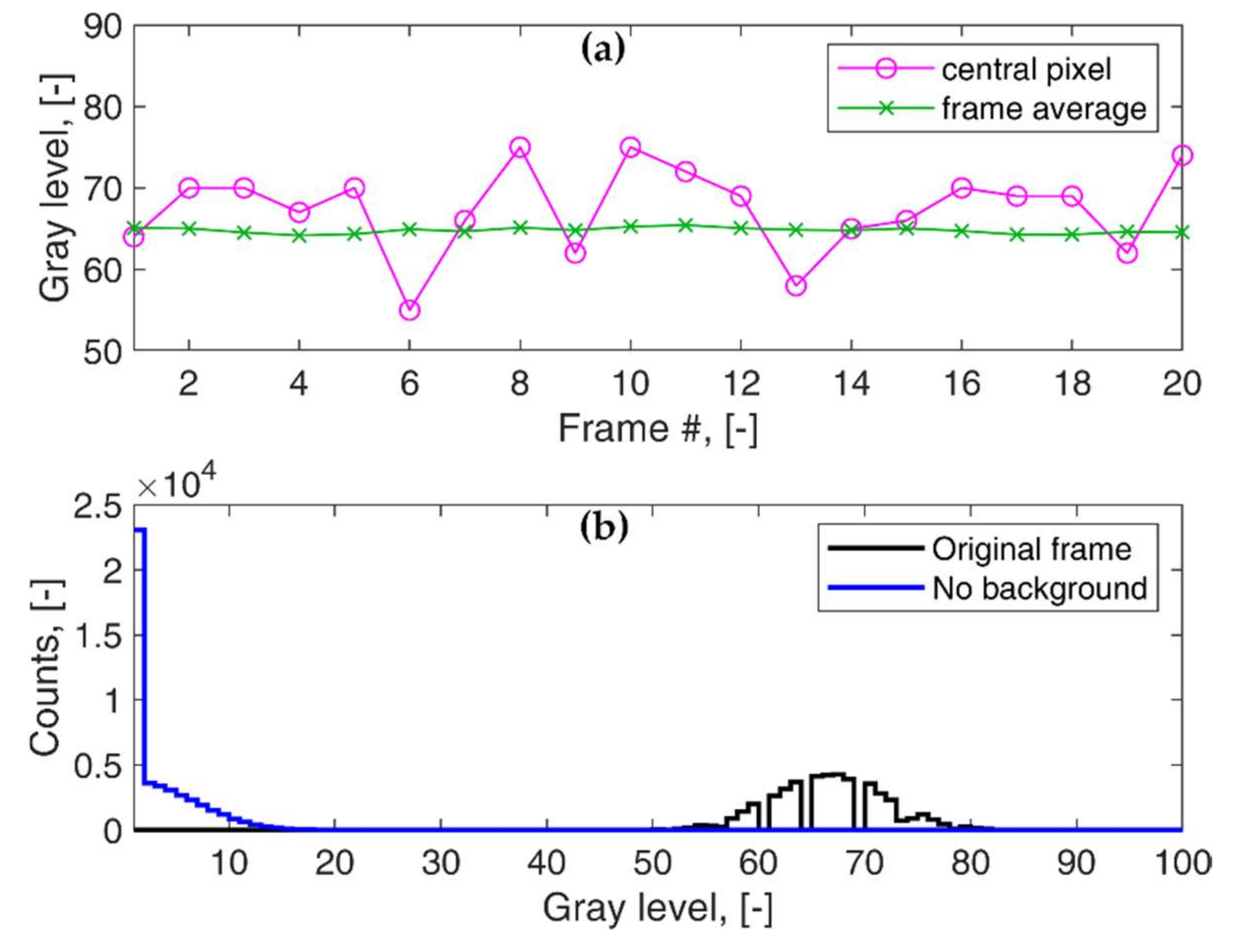
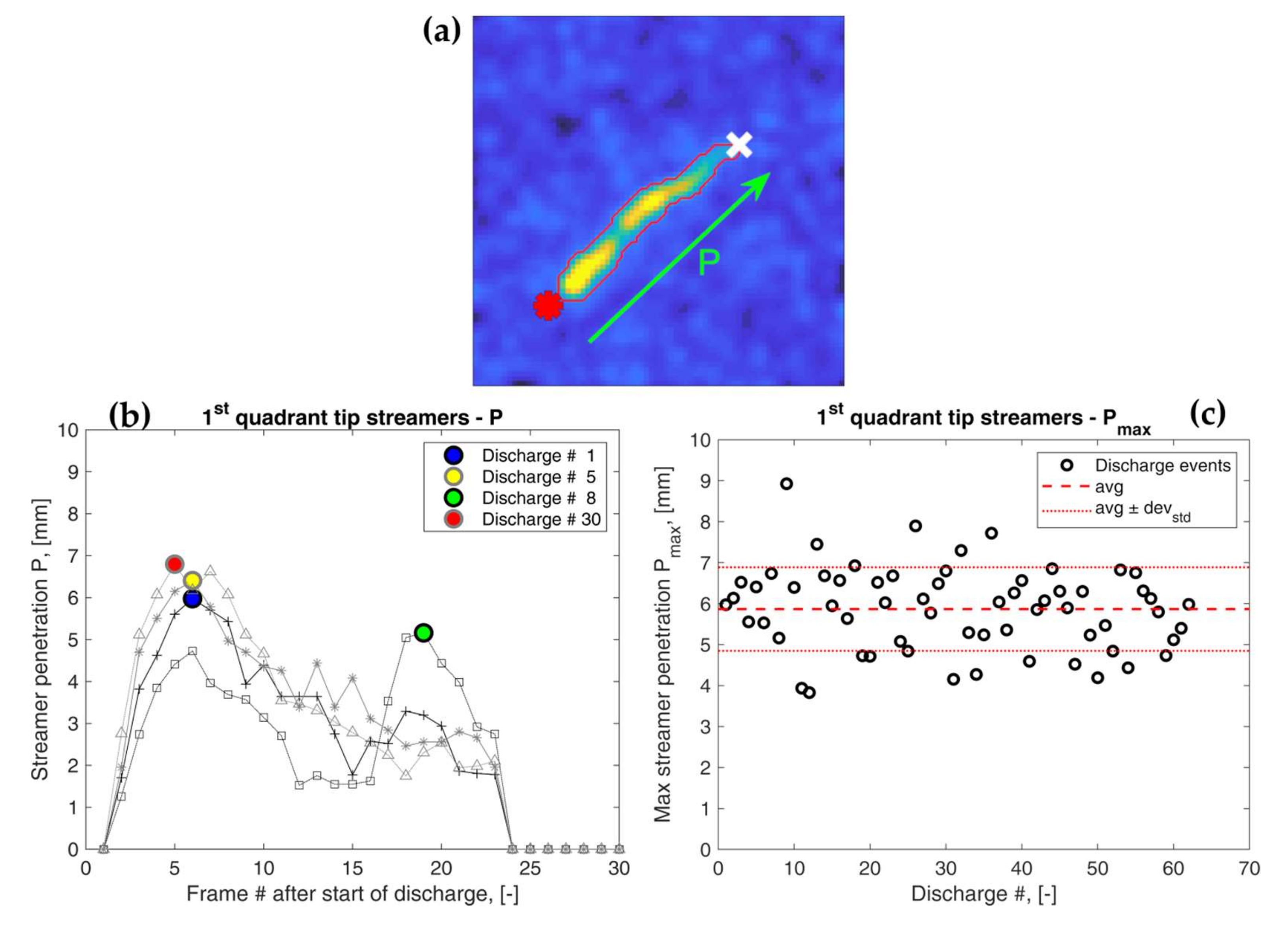
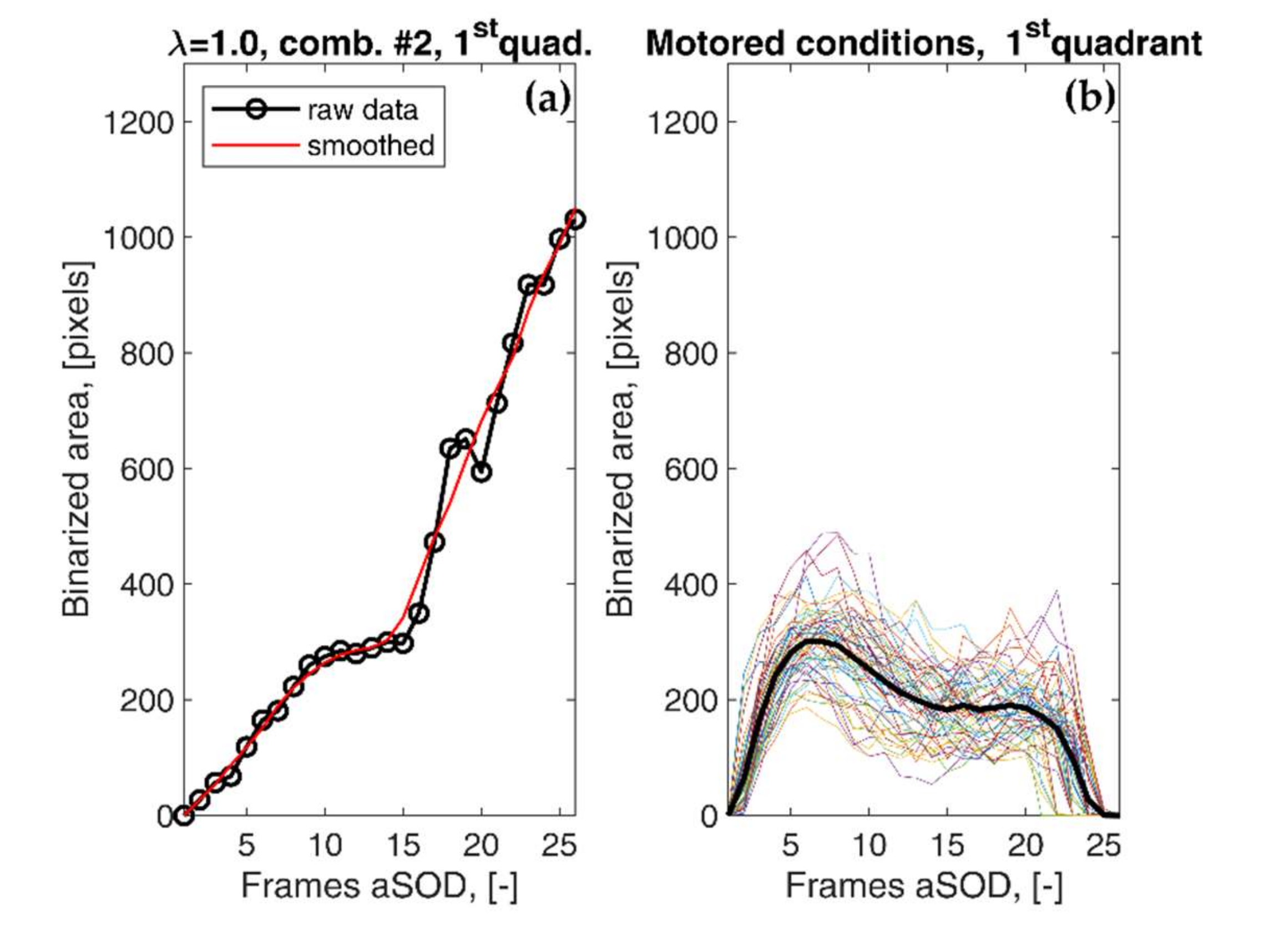
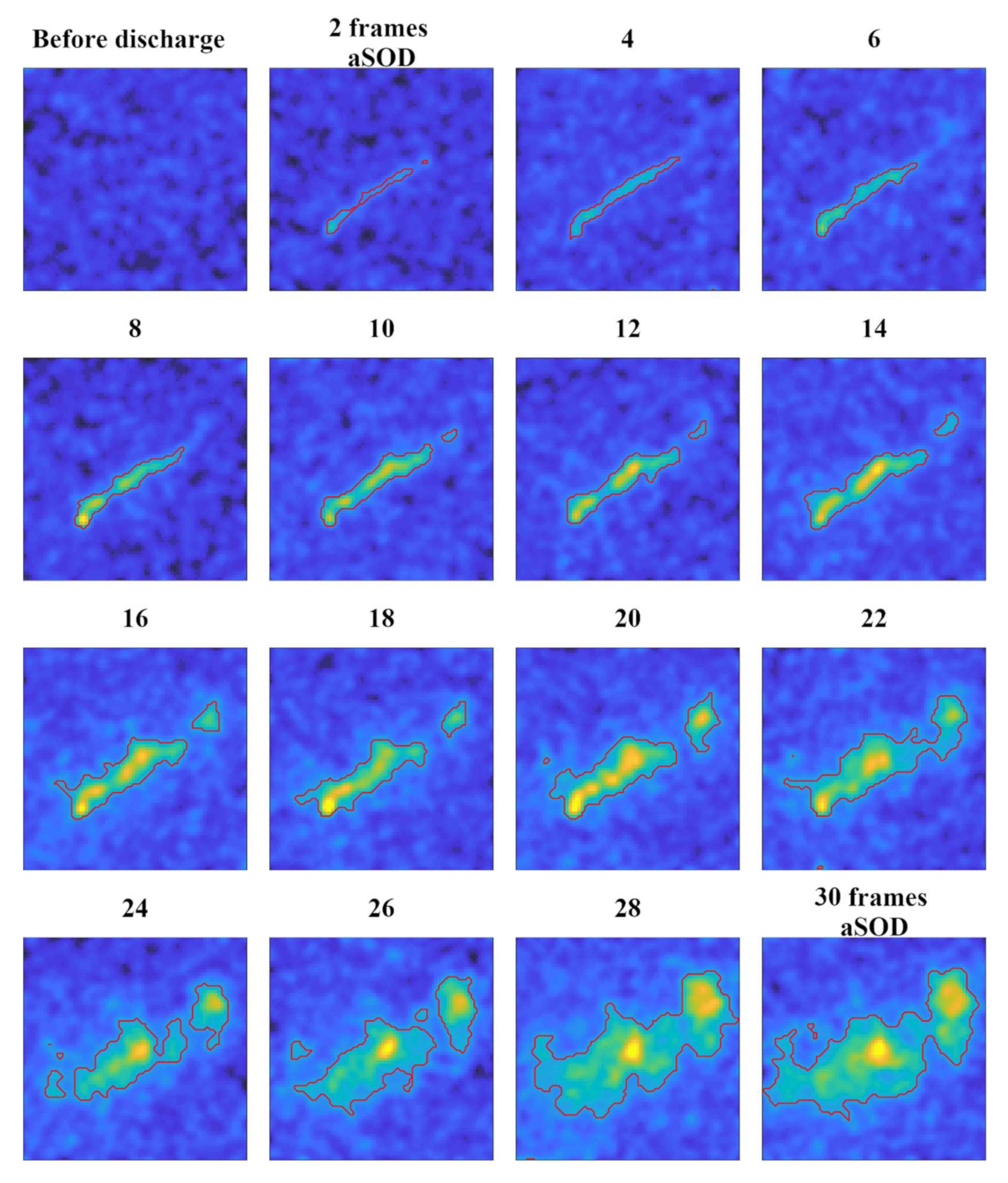
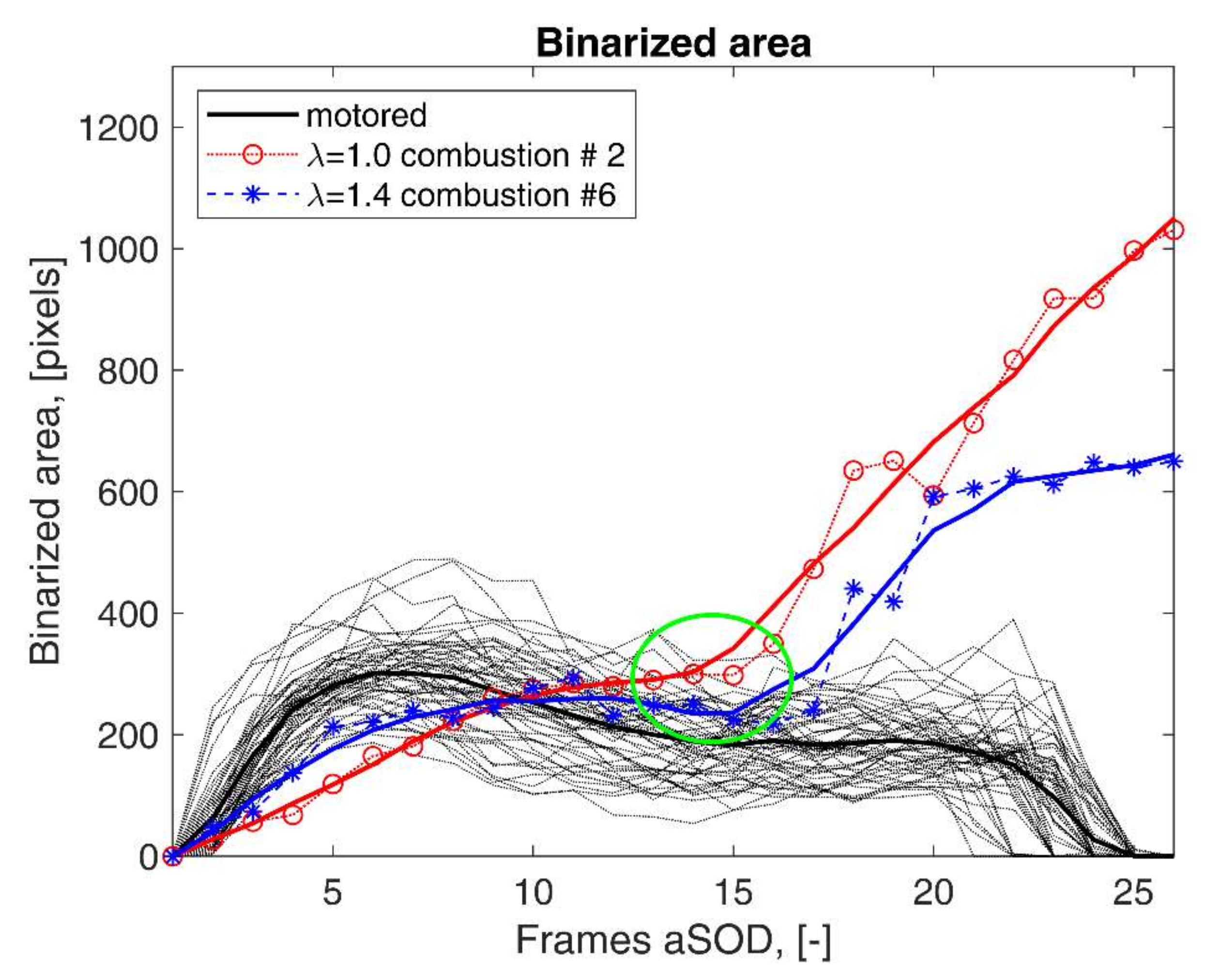
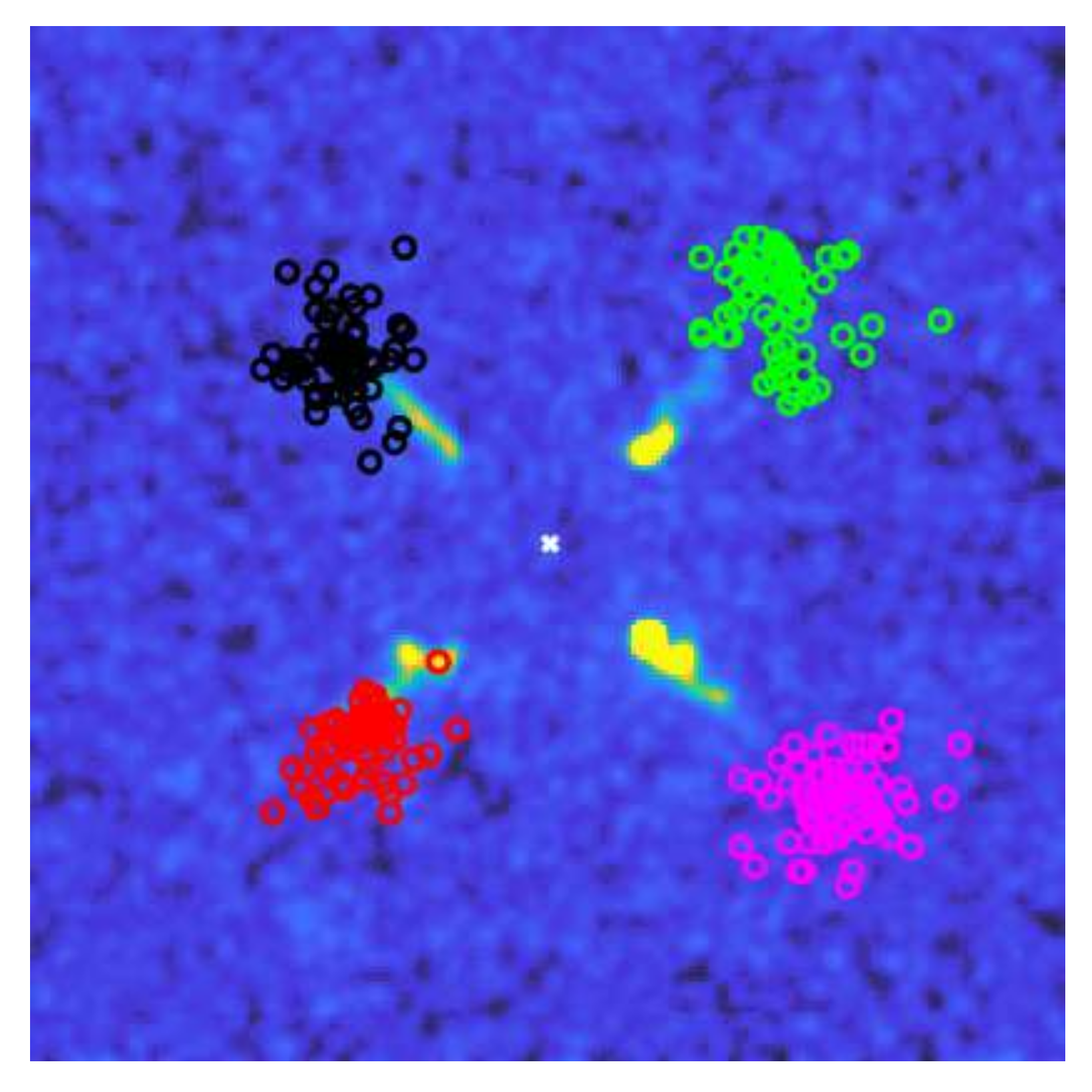
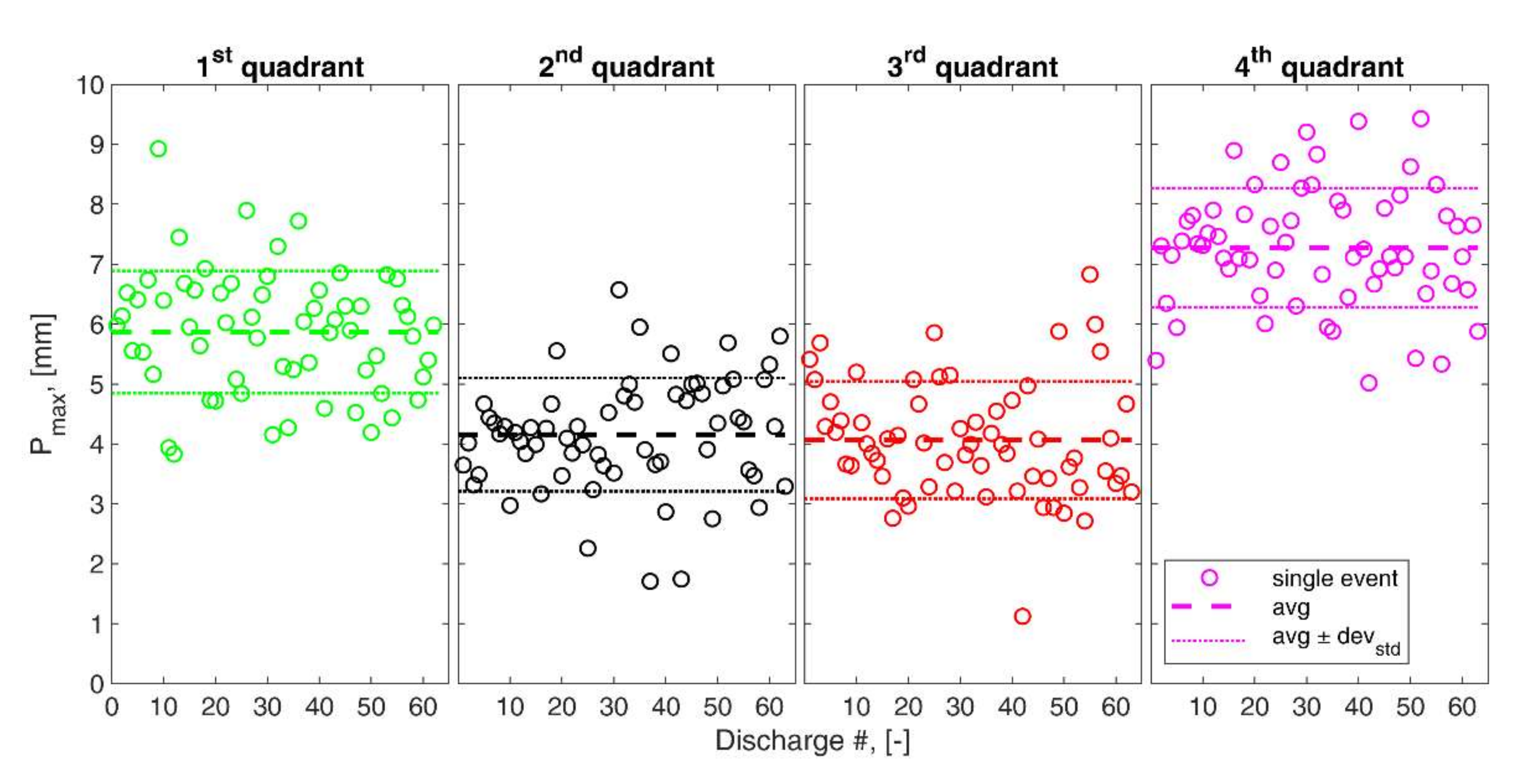
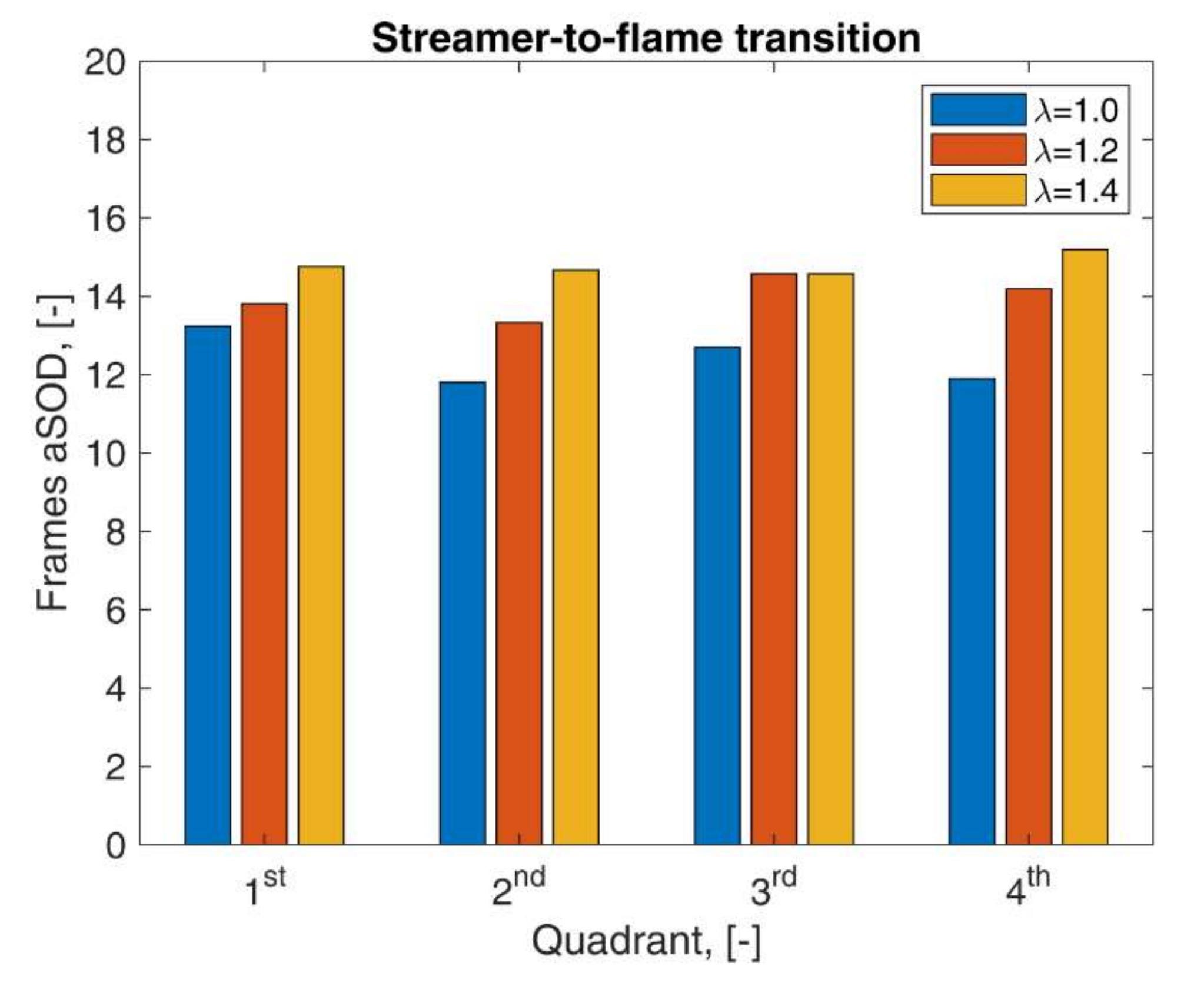
| Feature | Unit | Value |
|---|---|---|
| Displaced volume | cm3 | 500 |
| Stroke | mm | 88 |
| Bore | mm | 85 |
| Connecting rod length | mm | 139 |
| Compression ratio | - | 8.8:1 |
| Number of valves | - | 4 |
| Exhaust valve open | CAD bBDC | 13 |
| Exhaust valve close | CAD aTDC | 25 |
| Intake valve open | CAD bTDC | 20 |
| Intake valve close | CAD aBDC | 24 |
| In-cylinder residual gas mass fraction at the end of gas exchange process at λ = 1, 4.5 bar IMEP 1 | % | 9 |
| Device | Description | Specifications |
|---|---|---|
| Kistler Kibox | Compact indicating system for signal acquisition and combustion analysis | Channels: 10 analog input + 2 encoder input |
| Kistler 6061B | In-cylinder piezoelectric pressure sensor | Sensitivity: 25.9 pC/bar. Range: 0–250 bar |
| Kistler 5011B | Charge amplifier | Scale: 10 bar/V |
| Kistler 4075A5 | Piezoresistive pressure sensor, used for the intake line, downstream of throttle; reference for in-cylinder pressure pegging | Sensitivity: 25 mV/bar/mA Range: 0–5 bar |
| AVL 365C | Optical encoder for crankshaft angular position and engine speed measurement | Resolution up to 0.1 CAD |
| Horiba Mexa 720 | Fast lambda probe | Output: AFR, λ, and [O2]; can be used with different fuels via O/C and H/C ratio setting |
| Vision Research Phantom V710 | High-speed CMOS camera | See Section 2.2 and Table 3 |
| Bosch 0232103052 | Automotive camshaft sensor used as trigger for high-speed camera | — |
| Feature | Unit | Value |
|---|---|---|
| Image resolution | pixel | 256 × 256 |
| Sampling rate | kHz | 79.0 |
| Exposure time | μs | 12.3 |
| Bit depth | bit | 8 |
| Spatial resolution | μm2/pixel | 125 × 125 |
| Temporal resolution @ 1000 rpm | CAD/frame | 0.0759 |
| Number of consecutive events recorded | - | 63 |
| Feature | Unit | Motored | Fired λ = 1.0 | Fired λ = 1.2 | Fired λ = 1.4 |
|---|---|---|---|---|---|
| Engine speed | rpm | 1000 | |||
| Air throttle position | — | fixed | |||
| Ignition timing | CAD bTDC | 20 | |||
| Fueling | mg/stroke | — | 20.5 | 17.6 | 15.7 |
| Driving voltage Vd | V | 28 | |||
| Discharge duration Td | μs | 300 | |||
| IMEP | bar | — | 2.0 | 1.8 | 1.4 |
| Max in-cylinder pressure | bar | 8.8 | 23.5 | 18.5 | 13.0 |
| θ50 | CAD aTDC | — | −2.3 | 4.1 | 14.1 |
| Feature | Unit | 1st quadrant | 2nd quadrant | 3rd quadrant | 4th quadrant |
|---|---|---|---|---|---|
| Series average | mm | 5.87 | 4.15 | 4.11 | 7.27 |
| Series standard deviation | mm | 1.02 | 0.947 | 0.911 | 0.994 |
| Series CoV | % | 17.4 | 22.8 | 22.1 | 13.7 |
© 2020 by the authors. Licensee MDPI, Basel, Switzerland. This article is an open access article distributed under the terms and conditions of the Creative Commons Attribution (CC BY) license (http://creativecommons.org/licenses/by/4.0/).
Share and Cite
Cruccolini, V.; Grimaldi, C.N.; Discepoli, G.; Ricci, F.; Petrucci, L.; Papi, S. An Optical Method to Characterize Streamer Variability and Streamer-to-Flame Transition for Radio-Frequency Corona Discharges. Appl. Sci. 2020, 10, 2275. https://doi.org/10.3390/app10072275
Cruccolini V, Grimaldi CN, Discepoli G, Ricci F, Petrucci L, Papi S. An Optical Method to Characterize Streamer Variability and Streamer-to-Flame Transition for Radio-Frequency Corona Discharges. Applied Sciences. 2020; 10(7):2275. https://doi.org/10.3390/app10072275
Chicago/Turabian StyleCruccolini, Valentino, Carlo N. Grimaldi, Gabriele Discepoli, Federico Ricci, Luca Petrucci, and Stefano Papi. 2020. "An Optical Method to Characterize Streamer Variability and Streamer-to-Flame Transition for Radio-Frequency Corona Discharges" Applied Sciences 10, no. 7: 2275. https://doi.org/10.3390/app10072275
APA StyleCruccolini, V., Grimaldi, C. N., Discepoli, G., Ricci, F., Petrucci, L., & Papi, S. (2020). An Optical Method to Characterize Streamer Variability and Streamer-to-Flame Transition for Radio-Frequency Corona Discharges. Applied Sciences, 10(7), 2275. https://doi.org/10.3390/app10072275










